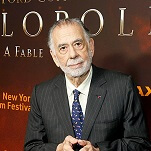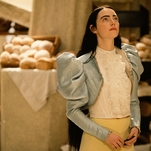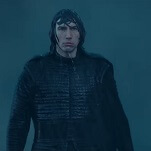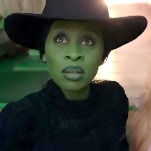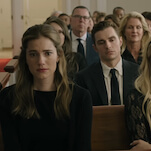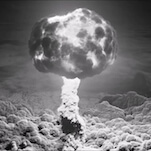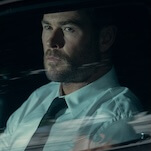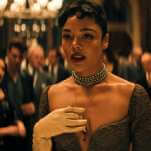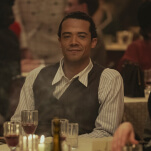Before Dark Shadows, American daytime television rarely veered from game shows and soap operas laden with ostensibly real-world drama: weddings, affairs, perhaps the occasional case of murder or mistaken identity, but no more. Yet midway through its very first season, Dark Shadows introduced supernatural elements into more familiar tales of blackmail and unrequited love in Collinsport, the ominous Maine fishing town where the show was set.
By the end of its groundbreaking, popular run, Dark Shadows had featured ghosts, vampires, witches, werewolves, Satan, raising the dead, reincarnation, brain swapping, time travel, parallel worlds, and a very persistent dream curse. Part of the success of such outrageous storylines can be attributed to the show’s ability to anchor them by alluding to well-known literary works, including everything from Greek mythology to the macabre stories of Edgar Allen Poe, to the entire canon of Gothic novels like Rebecca and Wuthering Heights. Yet even as much as the show looked to the past, it helped shape the future of its medium.
Dark Shadows has direct descendants in daytime TV, like the charmingly batty Passions or even Days Of Our Lives, which featured a storyline in which a prominent character was possessed by the devil. But the series’ influence goes far beyond the purview of Soap Digest. It helped solidify, if not invent, many of the ways in which TV viewers conceive of the supernatural—including the vampire tortured by conscience or love that lasts beyond the grave—and it paved the way for the confluence of science fiction/fantasy and drama. (These ideas weren’t invented by Dark Shadows, but the series was the first to bring them to television in a serious fashion.) Being Human, The Vampire Diaries, Twin Peaks, Buffy The Vampire Slayer, Angel, and dozens of other shows owe much to Dark Shadows. All employ a supernatural concept on which to hang more universal explorations of love, loyalty, family, and—perhaps more effectively than in programs grounded entirely in reality—death.
Many have tried to recapture the slightly hokey yet alluringly morbid magic of Dark Shadows, whether via a short-lived reboot in the ’90s, the turgid turd of a film adaptation by Tim Burton, or the various spin-off films and reunions made by the show’s creator, Dan Curtis. But no one has quite succeeded. For one thing, it’s impossible to recapture the excitement that attends an idea when it is one of the first of its kind. For another, there were factors present in the ’60s that cannot be replicated now—the sudden shift toward courting youth viewership, for example, which is now de rigueur—as well as factors that no one would choose to replicate. The live-to-tape format captured all manner of bloopers for posterity, from Jonathan Frid’s frequent line-flubbing (and one-time nose-picking), to actors walking into cardboard setpieces, to various crew members wandering into the frame. Yet somehow, these flaws made the show feel even more intimate and charming, and actually helped contribute to the feeling of danger and the sense that during the 20-plus minutes an episode was running, absolutely anything could happen.
Here are 10 episodes that showcase how Dark Shadows continues to spawn many creepy TV moments decades after it went off the air.
“Episode 70” (aired September 30, 1966): This is the episode that started it all, supernaturally speaking. Although vampire Barnabas Collins is now considered the star of the show, he actually didn’t appear until deep into season two. The first creature to go bump in the night was his eternal love (sort of), Josette Collins, who walks out of her painting in order to keep an eye on the orphaned governess Victoria Winters and creepy, semi-psychic kid David Collins. Up to this point, public reception of Dark Shadows was lukewarm, and ratings were low; the introduction of this ghost, who came to play a pivotal role in that season’s real-world horrors of murder and extortion, shocked audiences into paying attention and completely altered the show’s trajectory.
“Episode 212” (aired April 19, 1967): Although Barnabas appears briefly in a cliffhanger at the end of episode 210, reaching out of his stale coffin to grab Willie Loomis by the throat, he introduces himself as a long-lost relative to a descendant in episode 211, the first episode in which he is prominently featured. Many factors of Barnabas’ character are displayed, including his serious, brooding quality; a gravitas that intrigues but also unnerves all around him; and a sincere desire for connection tinged with danger and duplicity. This episode also manages to quickly set up several of his relationships with pre-existing characters like Victoria and David, as well his intense spiritual connection to the old Collinwood property, where he finds the portrait of his beloved Josette.
“Episode 236” (aired May 22, 1967): This episode, in which Barnabas abducts Maggie in order to make her his new Josette, is an unusual pick, rarely included in fan-favorite lists or anthology DVDs, but its significance to the show was thrown into sharp relief by the 2012 film’s inability to engage with the darker side of the series’ central romance. Tim Burton conflated Maggie Evans and Victoria for his film in order to suggest the purity of Barnabas’ love for one woman over centuries, but the show was willing to create a more complex situation in which Barnabas’ affections shifted according to need and desire. While Barnabas did maintain a particular focus on Josette, these early episodes revealed that the object of his affection was less important than the alleviation of his acute isolation and loneliness.
“Episode 291” (aired August 7, 1967): In a previous episode, the discovery of mutated blood cells in Maggie’s body offered up the idea of vampirism as a kind of disease. In this episode, Julia Hoffman confronts Barnabas with what he is, the first time a member of the household has caught on to the fact that he is a vampire. She suggests she can cure him, exploring the possible ramifications of a more modern, science-based approach to the supernatural. The update is a significant concept for both the evolution of vampire mythology in general, and for the character of Barnabas Collins in particular, who above all else craves normal, human interaction and sees Julia’s treatments as a beacon of hope. It is also the beginning of the weird and wonderful frenemy relationship between Julia and Barnabas that persisted through the end of the show.
“Episode 366” (aired November 20, 1967): After getting audiences used to the idea of ghosts, vampires, and various other fantastical creatures popping by Collinwood, Dark Shadows once again challenged all expectations when a séance that was meant to channel the ghost of Barnabas’ sister Sarah magically transports Victoria to 1795. Besides the novelty of the time-travel concept, the fact that all of the members of the 18th-century Collins house are played by the same actors from the present-day timeline reinforces the show’s themes of reincarnation, parallel worlds, and the cyclical nature of time. The shift to the 1795 timeline also allows the audience to meet Barnabas before he became a vampire and experience the dramatic events surrounding his turn.
“Episode 425” (aired February 9, 1968): Although the episode in which Barnabas becomes a vampire is significant, there is something accessible and downright rational about the passionate actions of the witch who changes him into one of the undead. Barnabas betrayed her, so she curses him. The quiet, vengeful spirit of this episode is far more unnerving, and speaks to the witch’s all-consuming obsession. Cursing Barnabas with vampirism and a lifetime of unhappiness is not enough; she must also personally lure Josette to her death, rather than letting the curse take its natural course. Barnabas’ misery is made truly complete a few episodes later in episode 430, when he attempts to bring Josette back from the dead and finds her a rotten, decomposing shadow of herself, a lesson on the consequences of disturbing the natural order.
“Episode 491” (May 13, 1968): Barnabas provides the spiritual force to bring Adam, a man made of stitched-together corpse parts, to life. This concept obviously borrows heavily from Mary Shelley’s Frankenstein, but it’s the creature’s parallels to Barnabas, a character the audience had already grown to sympathize with at this point, that bring a new dimension to a classic idea. The vampire might be more sophisticated and eloquent, full of old-world charm, but underneath that, he, like Adam, has an essentially brutal, animalistic urge to kill. Both characters defy the laws of nature and mortality by their very existence, and both feel a profound loneliness that cannot be alleviated through violent action alone.
“Episode 512” (aired June 12, 1968): Reverend Trask, Barnabas’ nemesis, returns to torment the vampire by summoning the souls of those he has killed. The idea of punishing a flawed but ultimately conscience-ridden creature such as Barnabas with reminders of his weakest, most violent moments is deeply disturbing, not to mention extremely effective. The parade of murders past was as haunting on Dark Shadows as it was years later in Buffy The Vampire Slayer, which offered a very similar sequence tormenting that series’ vampire with a conscience, Angel. On both series, this is a punishment that uses some of the story’s most potent themes: an inability to escape the past and the lingering consequences of actions.
“Episode 981” (aired March 30, 1970): Not content with ordinary, linear time-travel, later in its run, Dark Shadows introduced the idea of sliding along the time corridor to a parallel world in which the same characters have made different choices that led to different lives. Alternate reality is always fun for fans, who get to see the givens in the show’s regular universe blown up, and this episode also allowed Barnabas to experience a satisfying relationship for the first time in the entire series. A longtime favorite of comic books and occasionally movies and television via dream or fantasy sequences and the like, the alternate-reality episode has now become a hallmark of television, popping up in the likes of, yes, Buffy The Vampire Slayer, but also in shows with no science-fiction/fantasy angle, like Friends, Boy Meets World, and Roseanne.
“Episode 1061” (aired July 20, 1970): How does a series top an episode in which characters travel to the past? By having them travel to the future, of course. This episode introduced the inconceivable idea that, far worse than being the site of one supernatural tragedy after another, worse even than the relatively mild deterioration of the old Collins estate in the years after Barnabas’ imprisonment, there could be a world in which the mansion is in such a state of ruin it practically doesn’t exist. This came as a huge shock for both the characters in Dark Shadows and its viewers, and the episode gave the series a renewed sense of purpose outside of romance and vengeance at a time when it could have become stagnant. Barnabas and Julia return to the present determined to keep the hell they witnessed from coming to pass.
And if you like those, here are 10 more: “Episode 281,” “Episode 341,” “Episode 361,” “Episode 385,” “Episode 405,” “Episode 425,” “Episode 430,” “Episode 628,” “Episode 700,” “Episode 885”
Availability: The entire series was available on VHS by 1995. In 2012, MPI issued a complete box set—including a commemorative coffin—which is quite expensive (anywhere from $400 to $600). A random selection of episodes is available to stream on Netflix.
Next Time: Rowan Kaiser offers the perfect way to dig into one of the most serialized shows ever, Babylon 5.


